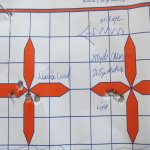Besides the fact that the worlds leading ballistician says that positive compensation is not really a real effect, not with the quality of todays rifles and free floating barrels, ladders such as the ones you are shooting (which are a form of positive compensation loading), seem to be confusing as hell for people.
I've seen a lot of people chase their tails on CGN with these kind of ladders, trying to read the tea leaves to figure out what the best load is.
My personal suggestion, is to use a decent chronograph to develop a load with the charge weight that gives good ES/SD, and from there testing the bullet seating depth to optimize precision. This can easily be done at 100 yards, and if done properly, will give you a good shooting load from 100 yards to 1,000+.
I feel that low ES/ED has a lot to do with the accuracy of your reloading techniques than the actual components. You speak of chasing tails but without knowing the OPs reloading setup and consistency ES/ED can be the king of all tails. I think ladders are a bit more forgiving unless you cannot shoot consistently at the bench. Consistency and proper procedures from case prep on have more impact on lowering or raising SD/ED than actual powder charge accepting the fact that there will be low ES/ED nodes for each powder/primer/bullet combo. These nodes are usually located between the low and middle charge load and again when case is full or even slightly compressed although with certain powders pressure stops us from hitting that node. Without finding the velocity node for the given barrel AND using proper reloading techniques and tools to lower ES/ED you cannot find an accurate load for a given rifle. I also feel that the results of the Audette Ladder and the 10 shot method will ape each other. You will more often then not find that this is also close to the high end powder node for ES/ED.
If you understand how to PROPERLY shoot an Audette ladder there are no tea leaves at all. The answer is as easy as reading the newspaper.









































































